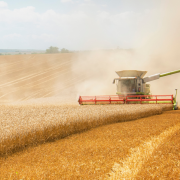Maximising Grass and Silage Growth
Over the past number of weeks, we have experienced very little grass growth due to a 75mm soil moisture deficit. Growth rates in this area dropped to around 30kg DM/ha which led to a lot of animals receiving a buffer feed. Luckily, we have got a welcome dash of rain over the past few days which in the presence of available nutrients has brought growth levels back up to 90kg DM/ha. As we are all starting from low farm covers, we need to maximise growth to deal with the recent shortfall of grass production. First cut silage has also been affected by drought conditions with 25-30% reduction in yields being reported locally. The quality of this first cut silage should be very good and most crops were saved in great conditions.
Grazing ground
Nitrogen N
Paddocks that have received nitrogen in the past few weeks should take this up now. Fields that have not been spread for over 3 to 4 weeks should get nitrogen immediately. The increased growth after the rain should enable 2 units a day to be taken up.
Phosphorous P
P is a key driver of growth, root development, and grass tillering. Available P will help stressed plants recover and promote water and nutrient uptake. In addition, it will promote grass tiller development to help swards recover after the dry spell. Therefore, apply low to medium rates of P in your next fertiliser application. Low index soils will require larger amounts of P depending on when they last received it. Earlier spring applications of P in low index ground will need to be topped up at this stage as P is locked up in these soils.
Potassium K
K has a major role to play in the uptake and regulation of water within the plant. Now more than ever sufficient levels of soil available and applied K will be essential for the plants to withstand drought and aid rapid recovery. K at sufficient levels will keep good quality leaf in the grass and stop it from droughting out, pushing up a seed head and going to stem. Stem has one third less feed value to the cow as green leaf.
Sulphur S
Sulphur increases the efficiency of N uptake which is very important at this time of the year. Sulphur aids in plant protein production and therefore grass that has sulphur will remain higher in protein and retain feeding quality later into the season. Sulphur should be a part of all fertiliser applications. In most cases an application of a compound containing N P K S will be the best solution to get farm covers back up where they need to be. Take the full advantage of the growth while we have it to build up much needed reserves.
Silage ground
The present damp dull weather makes it ideal for slurry applications. Most slurry spread during the dry spell will have lost all its nitrogen content. It is important to know your offtake when it comes to spreading your second cut silage, with each tonne of dry matter removing 25 kg (20 units) of N, 4 kg (3 units) of P, 25 kg (20 units) of K and 4 kg (3 units) of S. In low index P we must add 10 kg (8 units) per index lower than 3 and in low index K 30 kg (24 units) per index lower than 3. In general, we are low in sulphur so as a rule of thumb it is best apply 15 to 20 units per acre for your second cut. A 3 tonne DM/ha crop on an index 3, 3 will take 75N 12P 75K and 12 to 15 S out of your soil.
July Newsletter
To view our latest technical newsletter, please click here
Get In Touch
For the most up to date information on our products and services, please click here or follow us on Facebook and Twitter.











